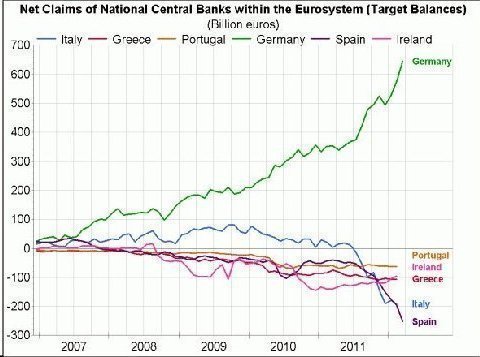It might seem strange to invoke Freddie Mercury and Queen in the context of the eurozone, but it’s the first thought that springs to mind, as Brussels and the increasingly hapless ECB, continue to mismanage their way to financial and economic catastrophe. Yesterday, there were signs that the Spanish plan to recapitalise Bankia (which came with the implied backing of the ECB’s balance sheet) introduced a potential way out of the eurozone’s metastisizing banking crisis. Sadly, it’s another idea which will never get off the bulletin board, as the ECB bluntly rejected any proposal to use its balance sheet to indirectly fund Bankia, the troubled Spanish lender
So we’re back to floundering and the markets are reacting accordingly. What most investors, experts, and policy makers fail to realize is that this bank run is not simply a Greek problem, which will cease if and when Greece is thrown out of the euro zone. If one looks at the Target 2 balances, the ELA, and the ECB’s lender of last resort facilities, it’s clear that this has extended into all of the periphery countries, including Spain and Italy. It may well end with Germany’s banks effectively serving as the deposit base for all of Europe. See this chart, courtesy of Gavyn Davies
Perversely, the ECB and the European authorities acknowledge none of this and seem to be doing nothing about it. At least not publicly. They are like ostriches with their collective heads in the sand. If anything, “tough talk” from some of them may be escalating the bank run, rather than restoring confidence.
All of the recent talk about euro bonds, fiscal union and higher capital adequacy buffers for the banks are fine in their own right. But they do not deal with the immediate problem of deposit flight. In theory, of all the financial maladies that exist, the one with which the world has the most experience and therefore has developed the most effective tools to address is a bank run. And the experience of the US in the Great Depression illustrates that deposit insurance is a proven cost-effective way of limiting downside risk in a financial meltdown. Bank runs are liquidity problems, not solvency problems. This is important because insolvent institutions rarely fail as long as they are liquid, which generally comes through the provision of the central bank’s lender of last resort facilities.
It is not necessary to restore the solvency of an institution when a bank run develops and incur all the trouble and expense that this entails. Arguably, on any honest accounting of America’s own Systemically Dangerous Institutions, they could well be insolvent, but there are no runs here because the system is backed by a robust system of deposit insurance via the FDIC. All one need do is reassure depositors that they can get their money out of the bank whenever they like. And paradoxically, that backstop makes it less likely that they will participate in a deposit run. Moreover, keeping deposits in a bank eliminates the need to liquidate the asset side of the balance sheet at fire sale prices. Even a normally solvent institution can become insolvent if it were forced to liquidate its assets too rapidly.
It is important to recall that central banks were not created to control inflation. They were created to prevent the bank runs that were so catastrophic for capitalist economies in the past. For all of its protestations to the contrary, the ECB has provided this backstop when catastrophe has loomed in the eurozone, but they have done so in a very reticent manner, undermining the effects of their action by publicly proclaiming each program to be absolute the last. So in effect, their “bazooka” becomes no more effective than a water pistol. This is encouraging the bank runs since people logically assume that there may be no one acting as the ultimate guarantor of the eurozone’s solvency.
And let’s be clear: in agreeing to the rules of the euro all members have implicitly committed to this responsibility of the ECB. Even Berlin! The fact the ECB is doing it clandestinely and via such gimmicky programs earlier such as the LTRO to such a vast extent shows that the ECB at some level knows this. Indeed, It may be that the LTRO scheme was hatched precisely because there were signs that the deposit run was in fact spreading to Italy and Spain in the second half of 2011.
But so long as there exists a healthy market skepticism that a strong supranational central bank will provide unlimited lender of last resort facilities to its weaker constituent parts, and so long as the ECB, and certain national central banks, continue to act clandestinely with a lot of threatening hard-line public talk, the runs will continue and the crisis will intensify.
Contrary to what the Germans are now indicating, a eurozone wide system of deposit insurance does NOT require the Germans guaranteeing the obligations of the Greek, Spanish, Portuguese, and Italian governments. This can and should be done by the ECB, as it is the issuer of the euro. It’s also in Germany’s massive interests to have these costs born by the central bank, rather than tainting its own credit rating via persistent bailouts of the eurozone’s weaker constituent parts. Because at the end of the day, Germany is a user of the currency as well and is trapped in the same roach motel as the Italians and the Spanish, even if it occupies the penthouse suite.













Pingback: Mirabile Dictu! Bloomberg Finally Notices Deposit Flight, a Major Threat to the Eurozone « naked capitalism
Pingback: DTMkoek aspaldian abisatu zuten | Heterodoxia, diru teoria modernoa eta finantza ingeniaritza